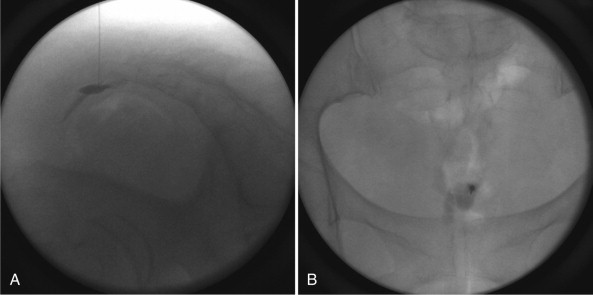A ganglion impar sympathetic block can be beneficial for pain from the distal rectum, anus, vulva, distal urethra, perineum, or the distal third of the vagina. Therefore, the block can help with pain in any of these regions. This pain can come after an injury/trauma to the area or even after surgery. By numbing this specific cluster of nerves, this can stop them from sending the pain signal, thereby alleviating your pain. Common pain condition that this procedure is used to treat include:
- Cancer pain in rectum, anus, vagina whether primary and/or as a metastasis
- Radiation-induced perineal pain
- Neuropathic perineal pain symptoms from any source
- chronic pelvic/perineal pain
Contraindications-
- Bleeding disorders/low platelet counts
- Medications that thin your blood (please review this section)
- Current infection
- No driver
- Your symptoms have changed and/or improved
- Patient refusal
- The procedure not approved by your insurance
- Poorly controlled high blood pressure that may be giving you symptoms
- Allergies to any of the medications that are being used
Potential side effects/risks of the procedure:
- Increased pain
- Numbness in lower extremities that is short-lived
- Infection
- Bleeding
- Allergic reaction
- Seizures
- Stroke
- Nerve and/or spinal cord injury
- Decrease in your blood pressure
- Heart palpitations
- Puncturing the surrounding organs
Procedure:
During the procedure, you will lying on your stomach. An IV may be started if you need sedation. An x-ray machine is used to locate the specific level of the spine which is believed to be causing your pain. This procedure is performed at the level of your tailbone. After your skin is cleaned with an antiseptic solution, typically betadine unless you are allergic, a series of x-rays will be taken to guide the needle placement.
The skin is numbed with a local anesthetic which is typically the most painful part of the procedure as this medicine has a tendency to burn when it is injected. After this point, you should only feel the pressure. If anything is too painful for you, please notify your physician as more numbing medicine can be given at any time. When the needle approaches the nerve cluster, contrast/dye is injected to confirm that the needle tip is in the correct position and not in a blood vessel. Next, a test dose of a local anesthetic solution is slowly injected. If you experience any side effects specifically numbness/tingling around your mouth, ringing in your ears and/or have a metal taste in your mouth, notify your physician immediately. This is a sign that the needle may be in the wrong position.
If you do not experience any of the above symptoms, a strong local anesthetic is injected. You may experience increased pressure in your tailbone/buttock area during the injection which is normal. If at any time the pain is too intense, please tell your physician. After the medication is injected, the needle is removed and the procedure is completed. You may experience pain relief after the procedure. This is a possible sign that the block has been successful.
The typical length of the procedure:
10 minutes. Expect to be at the clinic no more than 15 minutes after you have been checked in by the medical assistant into the preoperative area. If this is your first injection and/or you have had sedation, you will likely be at the clinic for at least one hour. Please plan accordingly.
How long do you expect pain relief?:
It is difficult to determine how long and how much pain relief you may experience. It varies depending on multiple factors. Some patients do not gain any relief from the procedure and some may have permanent pain relief. If you experience relief right after this procedure, this can be diagnostic that your pain is coming from the specific nerve(s) that was injected today.

